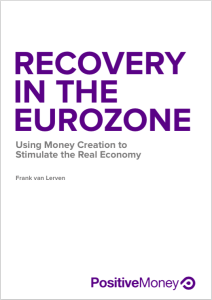Recovery in the Eurozone, Using Money Creation to Stimulate the Real Economy (NEW Report)

Positive Money has today released a report showing that the European Central Bank’s Quantitative Easing programme will fail to deliver the type of recovery that the Eurozone needs. Instead the ECB should create new money and inject this money into the real economy rather than the financial markets. Actually, our estimates indicate that putting newly created money into the real economy could be up to 14 times more effective at growing the economy than conventional QE.

Key points of the Paper
The ECB’s quantitative easing programme has been ineffective in delivering its primary objectives of producing higher spending, higher inflation and a return to economic growth
This is because it relies on incentivising the banking sector to increase lending. This is unlikely to happen because banks are focused on repairing their balance sheets
There are several proposals for how “QE for People” or “monetary financing” could direct new money into the real economy
These alternative monetary policy mechanisms can be expected to be many times more effective than QE in boosting demand and output
Download Here (Free, PDF, 49 pages)
“Classic” QE is an ineffective tool
To date, the ECB’s attempts to stimulate spending and aggregate demand have had limited success. The ECB has therefore chosen to replicate the Quantitative Easing (QE) policies used by Japan, the UK and the US. Between March 2015 and September 2016, the ECB will create €1.1 trillion of new central bank money and use this to purchase government bonds (and other asset-backed securities and covered bonds) from the financial markets. The ECB hopes that this process will result in higher spending, higher inflation, and a return to economic growth. But the channels through which QE works are weak and uncertain.
The ECB’s QE programme is intended to boost spending by incentivising the banking sector to increase lending and enticing households and businesses to borrow more. The success of the QE programme depends upon the private sector taking on more debt. But the banking sector is reluctant to expand its volume of lending, as it is presently preoccupied with repairing its balance sheet.
Bank lending is also demand-constrained: weak growth, low economic confidence, meagre potential for business expansion, and substantially high levels of unemployment mean that the private sector is more concerned with paying down existing loans than taking out new ones. It is highly unlikely that there will be a substantial increase in the level of private-sector borrowing, so this approach to generating a recovery in the Eurozone would almost certainly be ineffective.
If the Eurozone needs an economic stimulus to boost employment, output and a return to growth, then QE is the wrong tool to use.
There is an alternative
The QE for People campaign argues for an alternative approach to a Eurozone stimulus, in which the ECB still creates new money, but injects this money into the real economy rather than the financial markets.
There are several options for how monetary financing could boost demand in the real economy. Two examples are:
The ECB could transfer newly created money to the Eurozone national governments. These governments would then use the newly created funds to increase their spending. This additional spending could, for example, be focused on ‘green’ infrastructure projects.
The newly created money could be distributed equally between every citizen of the Eurozone. This type of “citizen’s dividend” would put additional purchasing power directly into people’s pockets.
Both of these proposals have significant benefits when compared to the ECB’s current QE programme. They would:
boost aggregate demand without relying on households and businesses to borrow more, and therefore would not cause a rise in already-high private sector debt. It would therefore compensate for the reduction in total spending caused by private sector deleveraging.
it would also increase the net financial assets held by the private sector, while the additional spending boosts private sector income and reduces the private sector’s debt-to-income ratio. These two effects increase financial stability.
In simple terms, QE works by flooding financial markets with billions of euros and hoping that some of it ‘trickles down’ to the real economy. In contrast, monetary financing is a tool that would grant policymakers greater macro-economic control over the real economy; and would also ensure that the benefits of central bank money creation are more evenly distributed. Similarly, unlike QE, monetary financing for the real economy avoids the risk of creating destabilising asset bubbles, and thus makes the recovery more sustainable in the long run.
The projected impact
Monetary financing for the real economy can be expected to be many times more effective than QE in boosting demand and output. For the Eurozone, statistical analysis of income and consumption patterns suggests that €100 billion of newly created money distributed to citizens would lead to an increase in GDP of around €232 billion. Using IMF fiscal multipliers, our empirical analysis further suggests that using the money to fund a €100 billion increase in public investment would reduce unemployment by approximately one million, and could be between 2.5 to 12 times more effective at stimulating GDP than current QE.
These figures are estimates and not certain predictions, but it is clear that if the ECB wishes to boost employment and meet its inflation target, then it would be better off using the ECB’s powers to create money to either finance public expenditure or distribute new money directly to citizens.
QE will fail to deliver benefits for ordinary people in the Eurozone. What is needed now is an alternative approach that puts new money directly into the real economy.
Download Here (Free, PDF, 49 pages)